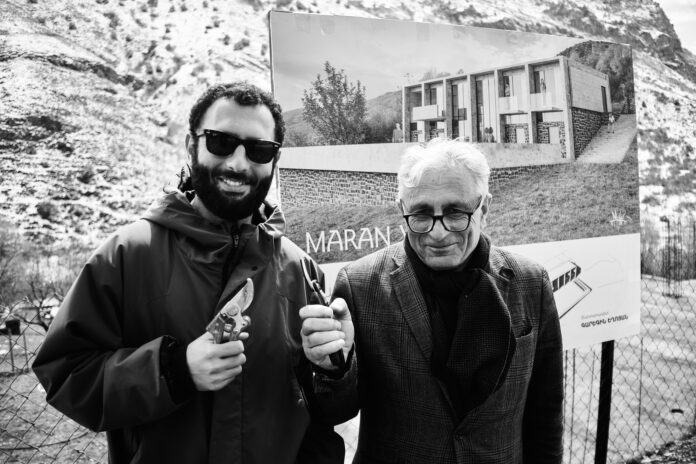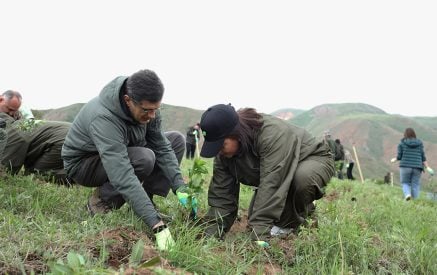by Paul Vartan Sookiasian
While winemaking in Armenia is a fabled tradition going back 6,000 years, it was abruptly halted due to the centralized Soviet economy decreeing a focus on brandy instead. Only restarting in the years after independence, Armenian wine’s rebirth is a new phenomenon, however some of the companies now making it have surprisingly deep historical roots which long predate the stoppage. They serve as a link between ancient tradition and the modern industry. Two brands in particular have fascinating stories of reclaiming a lost history, not just that of Armenia wine culture but of their own families’ links to it as well.
One example is Alluria, run by the Machanyan family from their vineyards near their ancestral home of Echmiadzin. Even before starting the company in 2016, winemaking wasn’t just a hobby for them; it’s in their blood.
Read also
According to Samvel Machanyan, Alluria’s co-creator and Chief Wine Enthusiast, growing up he assumed that every Armenian family made wine because it was such a part of his family life. Despite the end of commercial wine production in Soviet Armenia, Samvel’s grandfather kept it up as a hobby. He used techniques which had been passed down to him from his father, who had settled in Echmiadzin after fleeing his hometown of Aylur near Lake Van during the genocide. Thus it was a natural decision for the Machanyans to join the Armenian wine rebirth a decade ago, doing it the only way they knew how: “We want to present to the public our family’s traditional methods rather than follow the established techniques.”
This independent streak resulted in Alluria being Armenia’s first brand of “natural wine,” a niche variety mainly known among serious connoisseurs. Natural wines are set apart by only using native wild yeasts rather than commercial ones to start fermentation, and have no added sulfites. Drinking a natural wine is a different experience, and can be divisive amongst wine lovers, but the taste for it is growing internationally, and a few other brands in Armenia have followed their lead. While the Armenian populace is still mostly unfamiliar with it, Samvel notes the influx of Russians has brought with it a great many natural wine lovers. Alluria started with two wines, both reds, and now has nine varieties. What they plan next however will be the culmination of Alluria’s motto “a renaissance of family traditions,” and an incredible story of emotional discovery.

Samvel Machanyan of Alluria
In 2017, Samvel and some of his brothers made a pilgrimage back to their ancestral home of Aylur on a mission: find the vineyard their great-grandfather was forced to leave behind in 1915.
The Machanyan family had been engaged in winemaking, grape growing, and horse breeding there for centuries until being uprooted in 1915. The village is now inhabited by Kurds, and after asking around, the brothers were told of the site of an old vineyard which had belonged to Armenians, abandoned but with the grapes still growing wild. The vineyard was in the same place where the Machanyans were said to have lived, and as Samvel said, “We immediately felt a connection between our blood and those grapes. I was very emotional imagining my great-grandfather running around this vineyard as a child.”
They set out with their task, taking cuttings of the vines and transporting them back to Echmiadzin. Of those, one survived the transfer, which they call the “Mother Vine,” from which they planted a vineyard with fifty of its roots. Samvel estimates in five years they will have enough of these ancestral grapes to create the first hundred bottles of pure wine from it, but even prior to that they will be placing a few drops of it into each of their wines to infuse every bottle they make with that piece of family history.
Alluria isn’t the only modern Armenian brand with deep family roots. Maran Winery boasts a family two-hundred history going back to 1828 when their ancestors, led by the matriarch Maran, were able to repatriate to modern Armenia’s Vayots Dzor region from Persia due to the Treaty of Turkmenchay. After settling Maran planted a vineyard which the family cultivated until it was confiscated a century later by the Soviets, but a new vineyard was later acquired and Maran Winery, named for their ancestress, was founded as soon as independence was declared. Just like Alluria, Maran recently reclaimed part of their history when in 2021 they were able to purchase the original ancestral vineyard planted by Maran two hundred years ago. Though it had been abandoned for decades, the family is working hard to bring its vines back to life and expect it to bear fruit soon.
With this strong dedication to the past also comes a steady focus on the future. Maran has multiple forward-thinking projects, such as an experimental vineyard it calls the highest one in Europe, which was planted as part of a USAID-funded project in order to observe the effects of climate change. While it is currently not an effective place for growing, in the coming decades rising temperatures will reduce the suitability of the Ararat valley for wine, which makes the study and potential development of alternatives like this one an important goal. Maran also started Armenia’s first ever underwater-aged wine Halde in 2018, which uses the freezing, silent waters of Kari Lake on Mount Aragats to study how the wine is affected. Scientific inquiry showed that the underwater-aged wine was smoother and kept its freshness better than traditional wine.
Samvel of Alluria says these kinds of stories demonstrate Armenia’s wine heritage, which as he knows from personal experience “was kept alive by hobbyists through the artificial Soviet pause, and is now being combined with modern techniques and technology to make something even better.” Both Alluria and Maran are members of the Wines of Armenia umbrella brand, which promotes Armenia’s wine culture both at home and abroad. Samvel appreciates how organizations like it and the government’s Vine & Wine Foundation foster a family environment amongst the Armenian wine industry. “There isn’t competition between the member companies like you’d expect. We see wine as a creation or work of art rather than a product. There are different wines for different moments, different feelings and energies, which might vary day to day even in the same person. Wine lovers are very curious people, they won’t just find a single wine and never drink anything else, they are always searching for new feelings. There’s enough for everybody- and since our market isn’t just Armenia but the world, the potential demand is way more than any one of us could meet.” In this sense, the better Armenian wines get as a whole, the better it is for all involved.
“We’re here to showcase our region as the land where wine was born, and to return Armenia to the wine world map. If you’re a wine-lover looking for a different experience you are used to you should definitely drink Armenian wine. You will fall in love with it,” concluded Samvel Machanyan.



























































